This article contains affiliate links.
Despite its fearsome name, Stinging nettle is your friend. It’s a wild edible with character! Nettle is attractive, has an element of danger, and promises great reward. It provides food for us in the spring and cordage in the fall. Stinging nettle is one of my favorite wild edibles.
About the plant
Stinging nettle (Urtica dioica) grows throughout North America. I usually find it in moist environments near flowing water. I have seen nettle growing along creeks, rivers, and at the edge of moist meadows. The plant likes sun, so areas disturbed by humans are a good place to look for it. Look along trails that run beside streams.
Stinging nettles grow in dense stands. The plants are interconnected by a network of rhizomes that help them spread. Nettles have “square-ish” stems and can grow 8 feet tall. It is a handsome plant, with opposite leaves growing from the main stalk. The leaves themselves are broad, flat, and have an ovoid shape (ovate) that tapers to a point. The top of the leaf is noticeably darker than the underside. The leaf edges are conspicuously toothed.
Clusters of tiny flowers droop from below the joints where the leaves meet the main stem (axils). The flowers are brown and unimpressive whenever I see them.
For more precise descriptions that you can use to identify stinging nettle in the field, see the references at the end of this post.
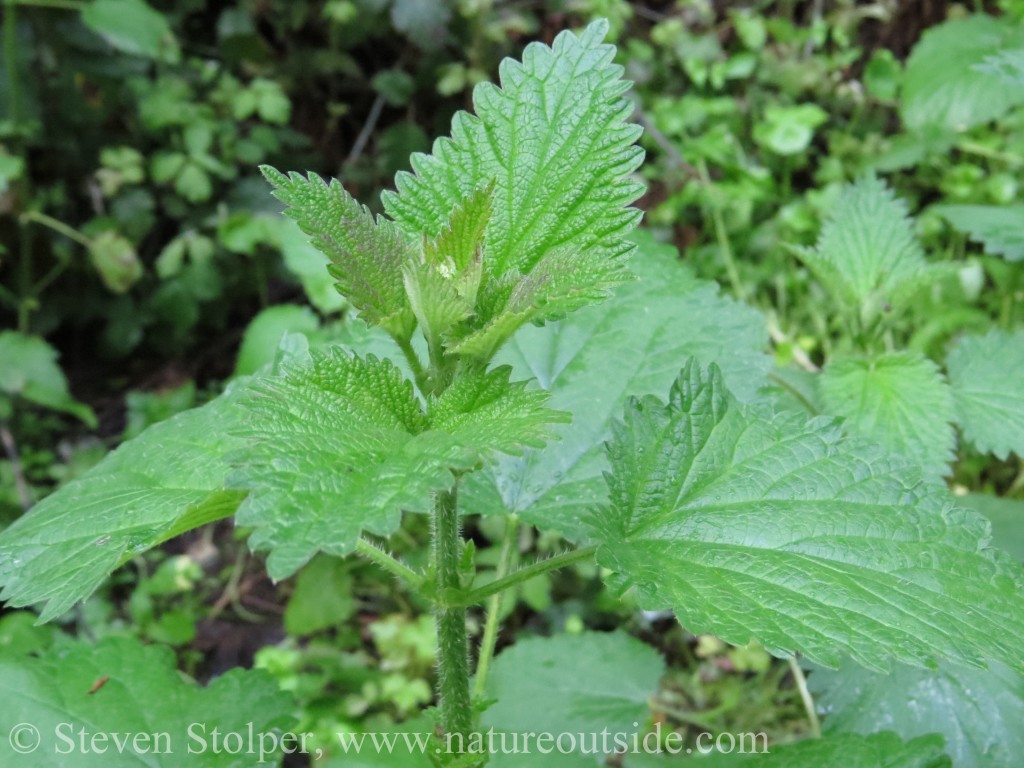
Stinging nettle
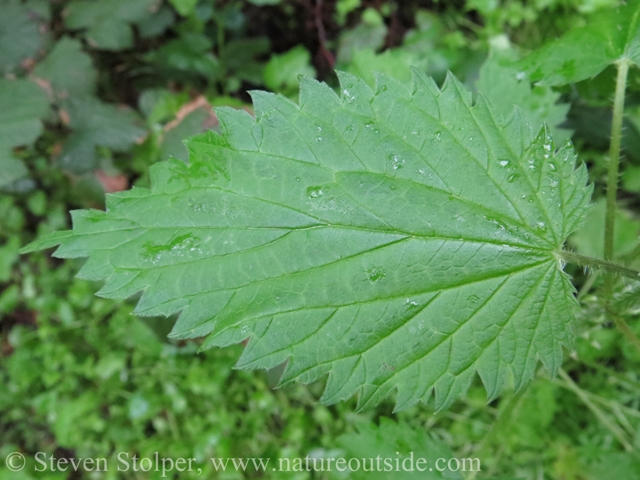
Stinging nettle leaf
The Sting
To the wild food forager who has learned to respect its sting and recognize its attributes, stinging nettle is a true delight. But to the unknowing explorer who haphazardly wanders into a stand of these plants, stinging nettle offers a crash course in plant identification (and contact dermatitis).
– Tilford, 2008, see below
The leaves of stinging nettle are covered with hollow, hair-like needles. So are the main stem and the leaf stalks (petioles). The hollow hairs act like hypodermic needles. Contact with them causes a cocktail of formic acid, histamine, and other unpleasant chemicals to be injected into our skin. Notice the needles in the various pictures of the plant.
The sting is painful, but not agonizing. The pain usually subsides within an hour or two. Stinging nettle is responsible for my only plant-ID-related injury. I absentmindedly rubbed a leaf between my thumb and forefinger, thinking it was wood mint. The pain lasted several days. Nature has ways of correcting us when we get sloppy. I considered that an inexpensive lesson. 🙂
Uses
Stinging nettle is used for food in the spring. For thousands of years it has been used in soups and as a pot-herb. It is also used to make a medicinal tea.
During the fall, the dried fibers of the main stem make excellent cordage. I collect them as or after they dry, but before they rot in the autumn rains.
This post only discusses processing nettles for food.
Harvesting Technique
Reminder
|
To harvest stinging nettles, we have to get past their formidable defenses. Wearing work gloves is one way to do this. Another is to slide a plastic bag, which is also used to store the leaves, over each one as you harvest it. Grasp the leaf through the bag to protect your hand as you cut the petiole.
You can harvest stinging nettle leaves with your bare hands. One method I use capitalizes on there being fewer needles on the top of the leaves. Using the pads of my thumb and forefinger, I grasp the leaf from the top where the petiole attaches to the leaf. By gently pinching/rolling the leaf, I can hold it with my fingers only touching the upper surface of the leaf. Do not grasp the leaf so hard that you push needles on the underside through the leaf into your fingers!
I pinch-off/pull the leaf using my fingernails. Using this technique I minimize the number of times I get stung. But I do not practice the technique enough to prevent stings completely. I recommend to anyone starting out that you harvest nettles wearing gloves or using a plastic bag for protection.
I have an acquaintance who claims to eat raw nettle leaves. He uses the bare-handed technique described above and then “rubs” the two halves of the underside of the leaf against each other. This mechanically breaks down the needles. At that point the leaf can be rolled into a ball and safely consumed. But I am too risk averse to try this technique, and my acquaintance has never demonstrated it for me. 🙂
Parts to Harvest
I generally harvest from the top 2-3 pairs of leaves. These are the youngest, choicest leaves on the plant. The older leaves can sometimes taste a bit “gritty” or “stringy”. I generally prefer the parts of a plant that are still growing, as they are often the most nutritious. Very young leaves sometimes have a purple tint on their upper surface. This is fine.
Harvesting Time
It is extremely important that you do not harvest leaves during or after the plant flowers! The plants absorb silicates from the soil and concentrates them in gritty particles (cystoliths) in the leaves. If we consume too many leaves during or after flowering it can result in irritation of the urinary tract. I like to harvest the leaves early in the spring.
Dangerous Company
Whenever we harvest a plant, we must pay attention to its habitat. This plant is no exception. In fact, one of the hazards I face when I harvest stinging nettle is the company it keeps.
Poison hemlock (Conium maculatum) often grows at the same locations as stinging nettle. When this happens, I take great care not to accidentally collect plant material from the hemlock. Sometimes, if the poison hemlock is too integrated with the nettle, I don’t collect from that location.
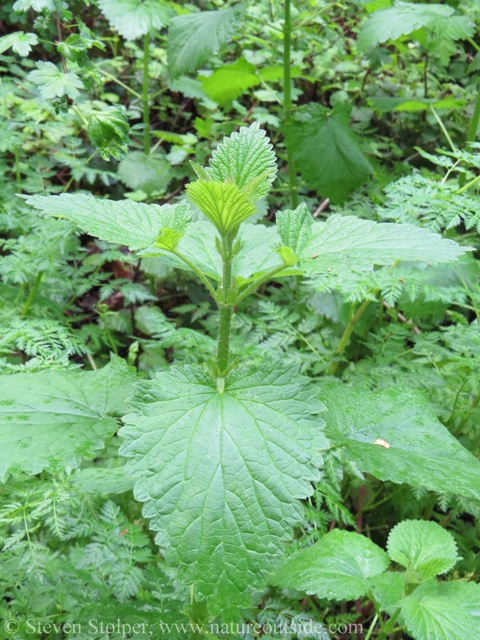
Stinging nettle surrounded by hemlock
When I first started harvesting nettle, I often confused it with wood mint (Stachys bullata). Wood mint looks at first blush like a small stinging nettle. However, it has a strong mint scent that I find unpleasant. You can rub the leaves between your fingers to bring out this scent. But don’t try this with a stinging nettle! Mixing wood mint leaves with your nettle will ruin your dinner.
Stinging nettle likes moist, sunny, disturbed areas. So it often grows next to agricultural sites. Pay attention to this, as the plant concentrates heavy metals and nitrogen. Do not harvest plants that might be drinking agricultural runoff!
Processing
We discussed the mechanical breakdown of needles by rubbing, above. But this is not a practical way to prepare nettles for dinner.
Heat drives off the formic acid and dissolves the needles. Cooking even for a short time will render the leaves safe to consume. Since cooking also improves the texture and flavor of the leaves, it is the approach I favor.
Another approach is to dry the leaves. I have not tried it so I cannot comment on this technique.
Nutrition
Use nettle wherever you would spinach. Like spinach, it is extremely nutritious. It is rich in vitamins A and C, iron, and potassium (Full nutrition information). As Thayer rightly points out…
If deer ever figure out how to cook, the nettles are going to be in big trouble.
– Thayer, 2006, see below
Cooking and Eating – My Favorite Recipe
Cooked stinging nettle has a wonderful taste! Its dark green leaves have a flavor I enjoy as a side dish or mixed into pasta. Use stinging nettle wherever you would cooked spinach. There is a long history of using stinging nettle for food. So you can find recipes dedicated to nettle in cookbooks, wild edible books, and on the internet.
Below is a recipe I use to prepare sautéed stinging nettle and spinach. I modified an existing Food Network recipe. However, I vary the amount of nettle and spinach depending on the number of servings I want, and my current inventory of ingredients. I also substitute garlic powder for the raw garlic when I do not have cloves. I always use the proscribed amount of olive oil. But I season to taste depending on the amount of nettle and spinach I use.
NatureOutside Nettle and Spinach Sauté
Ingredients: 1 1/2 pounds nettle leaves and/or baby spinach leaves 2 tablespoons good olive oil 2 tablespoons chopped garlic (6 cloves) 2 teaspoons kosher salt 3/4 teaspoon freshly ground black pepper 1 tablespoon unsalted butter Lemon Sea or kosher salt, optional
Directions: Place nettle in colander and rinse with cold water to make sure it’s clean. Do the same with the spinach. Make sure the leaves are dry, with just a little water clinging to the leaves. Too much water will cause the oil to splatter when you cook them. In a very large pot or Dutch oven (I use a pan with cover for smaller amounts of nettle and spinach), heat the olive oil and saute the garlic over medium heat for about 1 minute, but not until it’s browned. Add all the nettle and spinach, the salt, and pepper to the pot, toss it with the garlic and oil, cover the pot, and cook it for 2 minutes. Uncover the pot, turn the heat on high, and cook the nettle and spinach for another minute, stirring with a wooden spoon, until all the spinach is wilted. Using a slotted spoon, lift the spinach to a serving bowl and top with the butter, a squeeze of lemon, and a sprinkling of sea or kosher salt. Serve hot. |
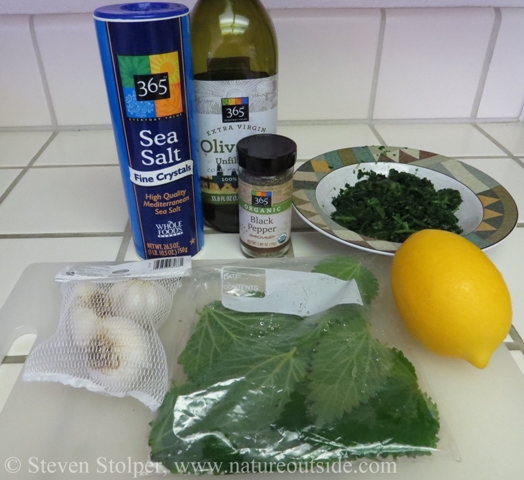
Ingredients
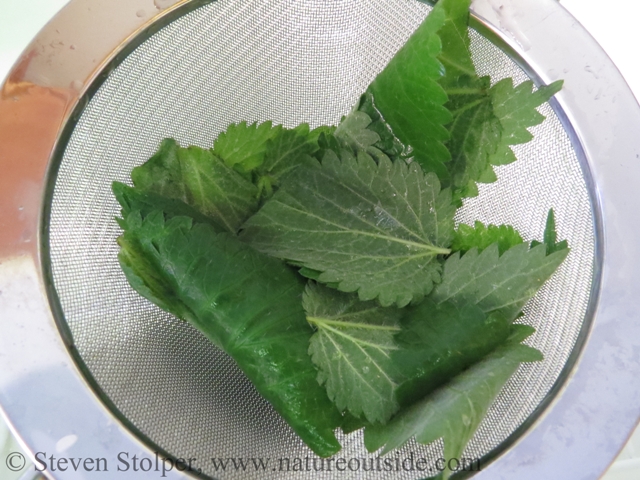
Washing leaves using collander and cold water

Cooking
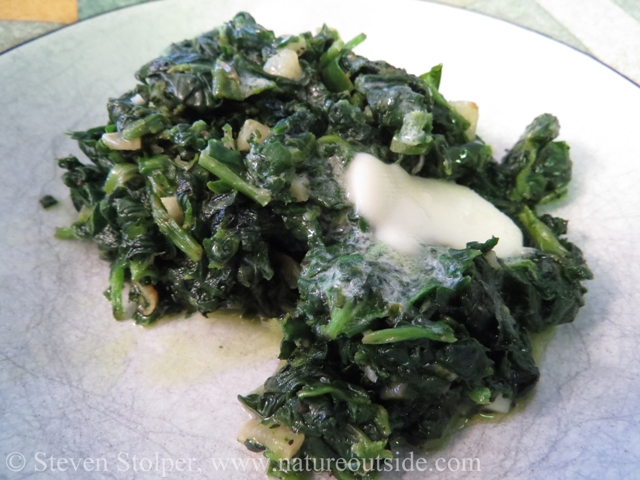
Viola!
Further Reading
When I started harvesting nettle, I relied on information I found in the three books below. All three are written by authors who whose works on wild edible and medicinal plants I greatly respect.
The Forager’s Harvest: A Guide to Identifying, Harvesting, and Preparing Edible Wild Plants, Samuel Thayer, 2006.
Edible and Medicinal Plants of the West, Gregory L. Tilford, 2008.
Medicinal Plants of the Pacific West, Michael Moore, 2011.
If you enjoy reading about wild edibles, here are more techniques for preparing wild edibles.
Share Your Thoughts
Do you have a favorite nettle recipe? A harvesting technique? Was this post helpful? I’d love to hear from you.
Related Articles on NatureOutside
How to Make Orange Acorn Bread
For fun facts and useful tips, join the free Bushcraft Newsletter.

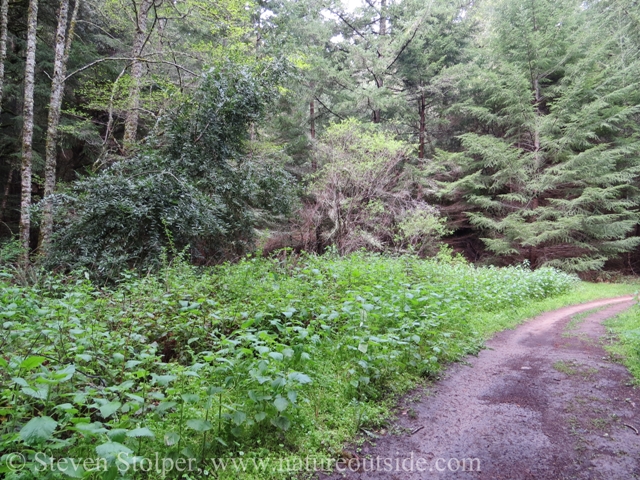
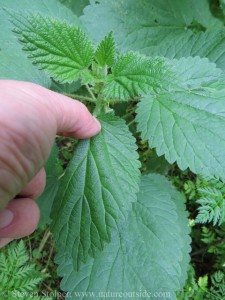


Terrific!
Cousin Mel
Fantastic article, appreciate the effort to put together and share… will have to give this a try.
Thanks, Keith! Let me know how your nettle cooking turns out.
– Steve
This article was a little disappointing the only information that you can put leaves left out is a legitimate grams and percentage count of the stinging nettles itself along with a list of vitamins nutrition proteins and everything like that that section was incomplete and it was the whole reason I checked this out due to the title of a post very disappointing
I’m sorry you were disappointed, Roy. The nutritional content of nettle leaves has been studied. So I should be able to find the information and add it to the article.
Dried leaves are easy to do and can be ground down and used as a powder year round for their nutritional value. They also make a great tea. Also check out the medicinal and nutritional values for Nettle Seeds! You’ll be pleasantly surprised. Here’s my recipe for:
Gomasio with Nettle Seeds and Sea Vegetables
1 Cup Sesame Seeds, toasted
1/2 Cup Sea Vegetables, granulated
1/2 Cup Nettle Seeds, dried
1 Tsp. sea salt or more
I prefer using an iron skillet and toast the Sesame Seeds until they impart an alluring smell and taste. Watch carefully and stir constantly so they don’t scorch. You can oven-roast them but again, stir often. Set the skillet aside and if you want, add the rest of the ingredients, stirring to meld as the mixture cools.
I purchase my Sea Veggies already granulated but you can grind your own remembering everything will be ground together later so you don’t want them too fine. Or if finely ground, use less. It’s up to you.
Add the mixture to a food processor and pulse/grind to a consistency you prefer. We use Gomasio sprinkled on toast, hummus, rice dishes, steamed vegetables, in soups, etc. It makes for great gifts, too. :
Thank you for the recipe, Patricia! Having delicious options for preparing wild edibles keeps us excited about gathering and processing them.